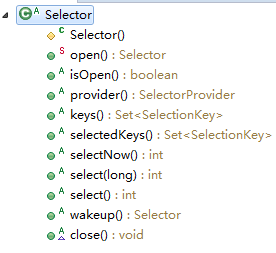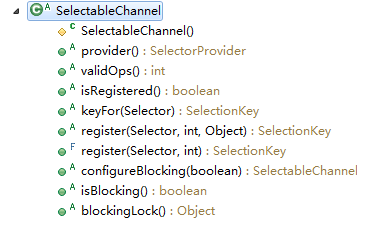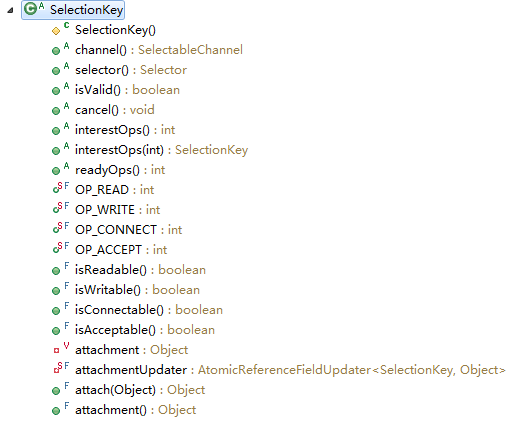Selector
Selector是Java NIO中能够通过单线程管理多个NIO通道的组件,而在单线程下实现这个操作就必须需要异步才能实现。
在非NIO模式下,即jdk1.4之前的IO阻塞式IO(Blocking IO)下,传统的java socket监听解决方案是为每一个socket连接建立一个线程,并且在read()调用中阻塞,直到有数据读取进来。这事实上是把每个阻塞的线程当作socket监听器,把java虚拟机的线程调度当作通知机制来使用,很明显这是一种曲线救国的实现路线。毕竟线程的上下文切换还需要消耗额外的资源。所以并不是最高效的实现策略。
真正的就绪选择必须由操作系统来做。操作系统的一项最重要的功能就是处理I/O请求并通知各个线程它们的数据已经准备好了。选择器类提供了这种抽象,使得Java代码能够以可移植的方式,请求底层的操作系统提供就绪选择服务。
核心类
Selector

SelectableChannel

SelectionKey

使用方法
创建Selector
Selector selector = Selector.open();向Selector注册通道
当向Selector中注册Channel时,Channel必须是非阻塞的,所以不可以注册FileChannel,因为FileChannel没有实现SelectableChannel接口,不能配置为非阻塞状态模式。
channel.configureBlocking(false);
SelectionKey key = channel.register(selector, Selectionkey.OP_READ);当将通道Channel注册到Selector中时,需要在第二个参数中指定相应观察事件的集合interest集合,即SelectionKey中的几个代表状态的整数。如果想注册多种状态需要用位或(|)操作符进行连接。
| SelectionKey.OP_CONNECT | 连接就绪 |
| SelectionKey.OP_ACCEPT | 接收就绪 |
| SelectionKey.OP_READ | 读就绪 |
| SelectionKey.OP_WRITE | 写就绪 |
可以在注册完Channel到Selector之后,通过获取到的SelectionKey来获取ready集合key.readyOps();,即可以得到所观察事件是否就绪的一个位或操作之后的值,此时只需要使用相应的interest值与readyOps值取与(&)操作即可确定此事件是否就绪。或者使用JDK提供的四个API(而实际JDK底层代码也是取与操作进行判断的)如下:
key.isConnectable();
key.isAcceptable();
key.isReadable();
key.isWritable();SelectionKey中还可以添加一些附加对象来标识对应注册的是哪个Channel。方法有两种如下
Object attach = new Object();
// 方法1:在注册时候的第三个参数指定
SelectionKey key = channel.register(selector, SelectionKey.OP_ACCEPT, attach);
// 方法2:使用attach()方法指定
key.attach(attach);
//获取附加对象的方法
Object attached = key.attachment();选择通道
当向Selector中注册了通道,就可以调用select来获取有多少通道发生了我们所感兴趣的(interest集合)事件和。该方法及其重载返回的int值表示有多少通道已经就绪。亦即,自上次调用select()方法后有多少通道变成就绪状态。如果调用select()方法,因为有一个通道变成就绪状态,返回了1,若再次调用select()方法,如果另一个通道就绪了,它会再次返回1。如果对第一个就绪的channel没有做任何操作,现在就有两个就绪的通道,但在每次select()方法调用之间,只有一个通道就绪了。
一旦select()方法返回非零,就可以通过selector.selectedKeys()方法获得所有的以选择即已就绪SelectionKey,通过遍历获取到是SelectionKey的哪个事件就绪。注意每次迭代末尾的keyIterator.remove()调用。Selector不会自己从已选择键集中移除SelectionKey实例。必须在处理完通道时自己移除。下次该通道变成就绪时,Selector会再次将其放入已选择键集中。
// 阻塞到至少有一个通道在你注册的事件上就绪了。
selector.select();
// 和select()一样,除了最长会阻塞timeout毫秒(参数)。
selector.select(1000);
// 不会阻塞,不管什么通道就绪都立刻返回,如果无通道就绪,则立即返回零
selector.selectNow();
// 遍历就绪的SelectionKey
Set<SelectionKey> keys = selector.selectedKeys();
Iterator<SelectionKey> iterator = keys.iterator();
while (iterator.hasNext()) {
SelectionKey selectedKey = iterator.next();
if (key.isAcceptable()) {
// a connection was accepted by a ServerSocketChannel.
} else if (key.isConnectable()) {
// a connection was established with a remote server.
} else if (key.isReadable()) {
// a channel is ready for reading
} else if (key.isWritable()) {
// a channel is ready for writing
}
iterator.remove();
}唤醒Selector
某个线程调用select()方法后阻塞了,即使没有通道已经就绪,也有办法让其从select()方法返回。只要让其它线程在第一个线程调用select()方法的那个对象上调用Selector.wakeup()方法即可。阻塞在select()方法上的线程会立马返回。
如果有其它线程调用了wakeup()方法,但当前没有线程阻塞在select()方法上,下个调用select()方法的线程会立即“醒来(wake up)”。
selector.wakeup();关闭Selector
用完Selector后调用其close()方法会关闭该Selector,且使注册到该Selector上的所有SelectionKey实例无效。通道本身并不会关闭。
selector.close();Example
SelectorServerTest
package com.freud.nio;
import java.io.IOException;
import java.net.InetSocketAddress;
import java.nio.ByteBuffer;
import java.nio.channels.SelectionKey;
import java.nio.channels.Selector;
import java.nio.channels.ServerSocketChannel;
import java.nio.channels.SocketChannel;
import java.text.MessageFormat;
import java.text.SimpleDateFormat;
import java.util.Date;
import java.util.Iterator;
/**
* @author Freud
*/
public class SelectorServerTest {
public static void main(String[] args) throws Exception {
Selector selector = null;
ServerSocketChannel serverChannel = null;
try {
// 创建Selector
selector = Selector.open();
// 创建非阻塞Server Socket Channel
serverChannel = ServerSocketChannel.open();
serverChannel.configureBlocking(false);
serverChannel.bind(new InetSocketAddress(7994));
// 将ServerSocketChannel注册到Selector
serverChannel.register(selector, SelectionKey.OP_ACCEPT);
while (true) {
// 等待信道超时,超时事件为1秒
if (selector.select(3000) == 0) {
System.out.println("等待中...");
continue;
}
Iterator<SelectionKey> iterator = selector.selectedKeys()
.iterator();
while (iterator.hasNext()) {
SelectionKey key = iterator.next();
if (key.isConnectable()) {
System.out.println("Connecable.");
} else if (key.isAcceptable()) {
System.out.println("Acceptedable.");
handleAccept(key);
} else if (key.isReadable()) {
System.out.println("Readable.");
handleRead(key);
} else if (key.isValid() && key.isWritable()) {
// Do nothing
System.out.println("Writeable.");
handleWrite(key);
}
iterator.remove();
}
}
} catch (Exception e) {
if (serverChannel != null) {
serverChannel.close();
}
if (selector != null) {
selector.close();
}
}
}
public static void handleAccept(SelectionKey key) throws IOException {
// 接受客户端建立连接的请求
SocketChannel clientChannel = ((ServerSocketChannel) key.channel())
.accept();
// 非阻塞式
clientChannel.configureBlocking(false);
// 注册到selector
clientChannel.register(key.selector(), SelectionKey.OP_READ,
ByteBuffer.allocate(1024));
// clientChannel.register(key.selector(), SelectionKey.OP_READ
// | SelectionKey.OP_WRITE, ByteBuffer.allocate(1024));
}
public static void handleRead(SelectionKey key) throws IOException {
// 获得与客户端通信的信道
SocketChannel clientChannel = (SocketChannel) key.channel();
// 得到并清空缓冲区
ByteBuffer buffer = (ByteBuffer) key.attachment();
buffer.clear();
if (clientChannel.read(buffer) != -1) {
buffer.flip();
byte[] bytes = new byte[buffer.limit()];
int i = 0;
while (buffer.hasRemaining()) {
bytes[i] = buffer.get();
i++;
}
System.out.println(MessageFormat.format("接收到来自[{0}]的消息[{1}]",
clientChannel.getRemoteAddress(), new String(bytes)));
buffer = ByteBuffer.wrap(MessageFormat.format(
"你好,客户端. @[{0}],已经收到你的信息[{1}]",
new SimpleDateFormat("yyyy-MM-dd HH:mm:ss")
.format(new Date()), new String(bytes)).getBytes());
clientChannel.write(buffer);
} else {
// 没有读取到内容的情况
clientChannel.close();
}
}
public static void handleWrite(SelectionKey key) throws IOException {
}
}SelectorClientTest
package com.freud.nio;
import java.io.IOException;
import java.net.InetSocketAddress;
import java.nio.ByteBuffer;
import java.nio.channels.SelectionKey;
import java.nio.channels.Selector;
import java.nio.channels.SocketChannel;
import java.text.MessageFormat;
import java.util.Iterator;
import java.util.Scanner;
import java.util.concurrent.Executors;
/**
* @author Freud
*/
public class SelectorClientTest implements Runnable {
private Selector selector;
public SelectorClientTest(Selector selector) {
this.selector = selector;
}
@Override
public void run() {
try {
// select()方法只能使用一次,用了之后就会自动删除,每个连接到服务器的选择器都是独立的
while (selector.select() > 0) {
Iterator<SelectionKey> iterator = selector.selectedKeys()
.iterator();
while (iterator.hasNext()) {
SelectionKey key = iterator.next();
if (key.isReadable()) {
SocketChannel channel = (SocketChannel) key.channel();
ByteBuffer buffer = ByteBuffer.allocate(1024);
if (channel.read(buffer) != -1) {
buffer.flip();
byte[] bytes = new byte[buffer.limit()];
int i = 0;
while (buffer.hasRemaining()) {
bytes[i] = buffer.get();
i++;
}
System.out.println(MessageFormat
.format("Server返回Response为[{0}]",
new String(bytes)));
} else {
channel.close();
}
}
iterator.remove();
}
}
} catch (IOException e) {
e.printStackTrace();
}
}
public static void main(String[] args) throws Exception {
Selector selector = null;
SocketChannel channel = null;
Scanner scanner = null;
try {
// 创建Selector
selector = Selector.open();
// 创建非阻塞Socket Channel
channel = SocketChannel.open(new InetSocketAddress("127.0.0.1",
7994));
channel.configureBlocking(false);
// channel.connect();
channel.register(selector, SelectionKey.OP_READ
| SelectionKey.OP_WRITE);
System.out.print("Connection setting up.");
while (!channel.isConnected()) {
System.out.print(".");
Thread.sleep(1000);
}
System.out.println();
channel.write(ByteBuffer.wrap("Client startup..".getBytes()));
// 监听Selector的各种事件
Executors.newFixedThreadPool(1).submit(
new SelectorClientTest(selector));
while (true) {
// 控制台输入信息发送给Server
scanner = new Scanner(System.in);
channel.write(ByteBuffer.wrap(scanner.next().getBytes()));
}
} finally {
if (scanner != null) {
scanner.close();
}
if (channel != null) {
channel.close();
}
if (selector != null) {
selector.close();
}
}
}
}Server端测试输出
等待中...
等待中...
Acceptedable.
Readable.
接收到来自[/127.0.0.1:52836]的消息[Client startup..]
等待中...
Readable.
接收到来自[/127.0.0.1:52836]的消息[echo1]
等待中...
Readable.
接收到来自[/127.0.0.1:52836]的消息[echo2]
Readable.
接收到来自[/127.0.0.1:52836]的消息[echo3]
Readable.
接收到来自[/127.0.0.1:52836]的消息[echo4]
Readable.Client端测试输入与输出
Connection setting up.
Server返回Response为[你好,客户端. @[2017-04-21 18:00:24],已经收到你的信息[Client startup..]]
echo1
Server返回Response为[你好,客户端. @[2017-04-21 18:00:27],已经收到你的信息[echo1]]
echo2
Server返回Response为[你好,客户端. @[2017-04-21 18:00:30],已经收到你的信息[echo2]]
echo3
Server返回Response为[你好,客户端. @[2017-04-21 18:00:32],已经收到你的信息[echo3]]
echo4
Server返回Response为[你好,客户端. @[2017-04-21 18:00:35],已经收到你的信息[echo4]]参考资料
JAVA-NIO(英文版) - Ron Hitchens
JAVA-NIO(中文版) - Ron Hitchens(著) 裴小星(译)
Java nio tutorial : http://tutorials.jenkov.com/java-nio/index.html
并发编程网:Java NIO系列教程-中文翻译版 : http://ifeve.com/overview/